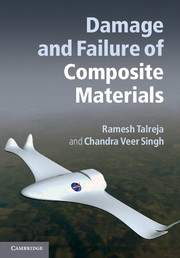Book contents
- Frontmatter
- Contents
- Preface
- 1 Durability assessment of composite structures
- 2 Review of mechanics of composite materials
- 3 Damage in composite materials
- 4 Micro-damage mechanics
- 5 Macro-damage mechanics
- 6 Damage progression
- 7 Damage mechanisms and fatigue-life diagrams
- 8 Future directions
- Author index
- Subject index
- References
7 - Damage mechanisms and fatigue-life diagrams
Published online by Cambridge University Press: 05 July 2012
- Frontmatter
- Contents
- Preface
- 1 Durability assessment of composite structures
- 2 Review of mechanics of composite materials
- 3 Damage in composite materials
- 4 Micro-damage mechanics
- 5 Macro-damage mechanics
- 6 Damage progression
- 7 Damage mechanisms and fatigue-life diagrams
- 8 Future directions
- Author index
- Subject index
- References
Summary
Introduction
The fatigue of composite materials presents a tremendous challenge when one considers the number and variety of parameters that can possibly affect the governing mechanisms. There is a considerable risk of the fatigue design becoming empirically based, and quite cost-ineffective, if rational guidelines based on physical models cannot be developed. To help alleviate this problem, we will in this chapter develop a mechanisms-based framework for interpretating the fatigue behavior of composites, beginning with the baseline configuration of unidirectional fiber-reinforced plies and proceeding later to laminate configurations and other fiber architectures. The framework in the form of fatigue-life diagrams will allow assessment of the effects of constituent properties, such as fiber stiffness and matrix ductility, and provide guidelines for fatigue design as well as for developing mechanism-based life prediction models.
After a review of the fatigue-life diagrams and their utility, we shall discuss the fatigue design methodologies, taking the examples of aircraft components and wind turbine blades. Finally, a mechanisms-based modeling of multi-axial fatigue will be discussed.
Fatigue-life diagrams
The S-N, or Wöhler diagram, originating from metal fatigue, is a familiar way to represent the resistance of a given material to the cyclic application of loads. It describes the observed fact that the material strength, given by the maximum stress sustained in the first application of load, reduces with repeated application of load, and is inversely dependent on the number of cycles applied. The strength value corresponding to a pre-selected large number of cycles, e.g., 106, is custom- arily taken as the fatigue limit. In some cases, a “true” fatigue limit exists, representing the stress value below which a fatigue mechanism cannot be initiated, but in most cases, one uses the operational definition of no failure until the selected high number of cycles.
- Type
- Chapter
- Information
- Damage and Failure of Composite Materials , pp. 237 - 275Publisher: Cambridge University PressPrint publication year: 2012



